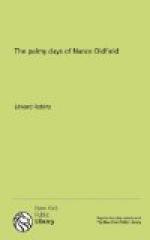Like Mrs. Porter, Ryan was a youthful disciple of Betterton, and was brought to the notice of Roscius in a curious fashion. One day, when Lacy had just begun, as a boy of sixteen or seventeen, to court the dramatic muses, he was cast for the role of Seyton, the old officer who attends on Macbeth, and was, no doubt, charmed with the assignment. To wait upon Macbeth, in however humble a capacity, was in itself no mean honour, and when the aforesaid Macbeth would be Betterton himself, the importance of the task was re-doubled.
That afternoon Ryan came on the stage in all the glory of a full-bottomed wig (imagine playing Shakespeare these days with full-bottomed wigs) and a smiling young face, being very much pleased with himself and the world in general. To Betterton, who had expected to see in Seyton a henchman of mature years, and who up to this moment had been unconscious of Lacy’s existence, the appearance of the boy came as a shock. Had the witches of the tragedy been turned into beautiful children he could not have been more surprised. However, he gave the new Seyton an encouraging look, and the stripling played the part in a way to earn the approbation of the great actor. After the performance was over, Betterton scolded old Downes, the prompter, for “sending a child to him instead of a man advanced in years.”
This anecdote seems to show that the art of “make-up” had not reached perfection in those times, for a few well-put strokes of the pencil should have destroyed the juvenile aspect of Seyton. It must not be supposed, nevertheless, that the decoration of the face was unknown, and an entry in Pepys’ delightful diary proves that “make-up” of a certain kind flourished at the Restoration. “To the King’s house,” says Pepys, “and there going in met with Knipp, and she took us up into the tireing-rooms;[A] and to the women’s shift, where Nell (Gwyne) was dressing herself, and was all unready, and is very pretty, prettier than I thought. (Imagine the gloating eyes of the old hypocrite.) And into the scene-room, and there sat down, and she gave us fruit: and here I read the questions to Knipp, while she answered me, through all her part of ‘Flora’s Figarys,’ which was acted to-day. But, Lord! to see how they were both painted, would make a man mad, and did make me loath them: and what base company of men comes among them; and how loudly they talk! And how poor the men are in clothes, and yet what a show they make on the stage by candle-light, is very observable. But to see how Nell cursed, for having so few people in the pit, was strange,” et cetera.[B]
[Footnote A: Mrs. Knipp was an actress belonging to the King’s Company and Mr. Pepys had for her a timid admiration.]
[Footnote B: In his notes to Cibber’s “Apology,” Lowe suggests the plausible theory that young actors playing “juveniles” did not use any “make-up” or paint, but went on the stage with their natural complexion. He instances this paragraph from Cibber: “The first thing that enters into the head of a young actor is that of being a heroe: In this ambition I was soon snubb’d by the insufficiency of my voice; to which might be added an uniform’d meagre person (tho’ then not ill-made) with a dismal pale complexion.”]




